The pulled pork process I developed that chunks butt meat, entails a smoke-cooking phase in large fibrous casings and then steam-oven finishes – works well. But, it’s unfamiliar to & seemingly intimidating for some people that lack knife skills and a well-rounded knowledge of meat science. This post is an attempt to reach a “middle ground;” where pork shoulder butts are left essentially whole and a process similar to rubbing meat with spices is used. Blade bone removal is advocated, however boneless butts are still widely available through many wholesale foodservice purveyors, for those people that would prefer to start out with them. The main advantages of this technique over the traditional smoke-cooking of butts are: much less labor & time intensive, comparatively low smoke-cooker unit cost, fly-ash/soot does not end up on/in the finished product, foil residue in not ingested because foil wrapping is not practiced and final (oven) phase cooking purge can advisedly be reincorporated into warm pulled pork. Don’t waste time with anything more than a short meat rest period, after the internal meat target temperature (200F neighborhood) is achieved.
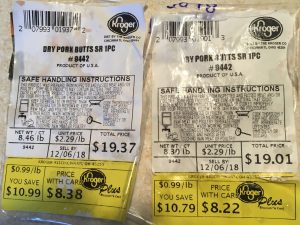
A local chain supermarket ran bone-in butts at 99 cents per pound on a Black Friday sale. These 2 were the biggest butts they had to offer at the time that I went shopping. I spent $16.60 for 16.76 pounds of bone-in, retail trimmed pork shoulder butts.
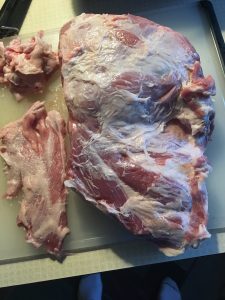

Fat over the thin cap muscle was removed, then the cap muscle was removed. After that all external roast fat was closely trimmed.
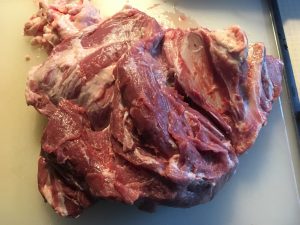
Here the pigskin side of the blade bone is exposed; only cutting across the flat underside of the blade bone remained to completely remove it. After blade bone removal the entire cut was closely gone over to remove any remaining bone fragments; as well as other objectionable materials (lymph nodes, blood clots, sloppy fat, etc.)
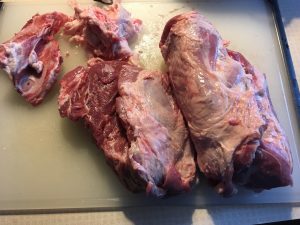
Heavy seam fat between the primary shoulder butt muscles was removed, however muscles were not completely separated.
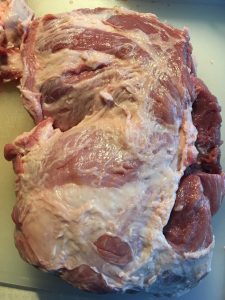
Boned-out and leaned up butt laid back together.
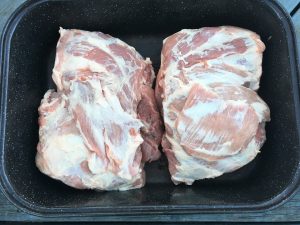
Fatted-down and with cap meat siting on top of trimmed butts.
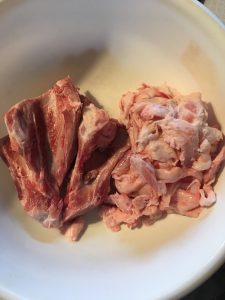
Removed fat, bone and bag purge (weep) weighed 2 1/4 pounds.
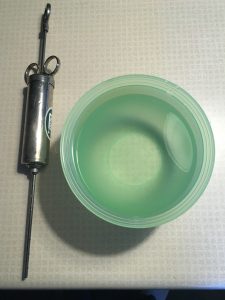
I filled this little bowl with about 5 cups of water then added 1 1/2 TBSP of roast sodium phosphate and the 5 1/3 TBSP of purified salt; which were needed for 14 1/2 pounds of meat. While it’s true that 16.76 pounds of butts were purchased, but there was that 2 1/4 pounds of fat and bone loss. Sodium phosphate was dissolved first because it’s harder to dissolve when salt is present. Tall, thin glasses were used to fill the hand brine pump as the remaining brine supply ran low.
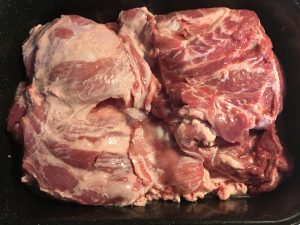
Here, both roasts were equally pumped with all the brine that I could get them to retain. After that, the cap muscles and all desirable looking trim fat was put down in the purged brine.
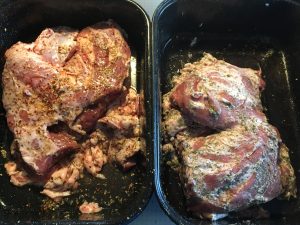
Roasts were then placed in the 2 different parts (pan & lid) of the large rectangular roaster. Excess brine, meat caps and trim fat was then equally divided between both containers. The roast on the left (Italian butt) was seasoned with 1 1/2 TBSP of red pepper flakes, 2 1/2 TBSP of fennel seeds and 2 tsp. of sugar. Polish was the other seasoning and it got 2 1/2 TBSP of leaf marjoram and 1 1/4 TBPS of fine ground black pepper. Both seasoning formulations were for the amounts needed to make 7 pounds of ground sausage.

In addition, 10 cloves worth of crushed garlic was divide between the two roasts.
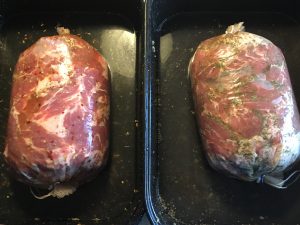
Cap meat and fat was placed in the seams of each roast, then they were each stuffed into a seperate cellulose ham casing.
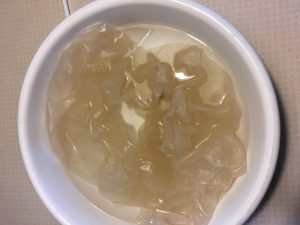
Prior to stuffing, ham casing were soaked in warm water that contained 1 tsp. of Prague powder # 1; for about 30 minutes. In the picture prior to this one you can see that the casing soak water was poured in with the stuffed roasts in an effort to further facilitate cure contact with the roast’s exteriors. Cure contacting lean provides a sure-fire faux smoke ring; plus a bit of characteristic cured meat flavor.
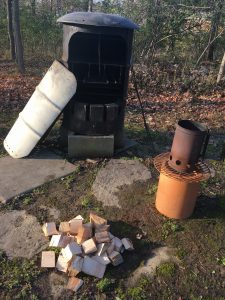
Smoke-cooker was set up the night before and a snow saucer was placed on top of it in case of rain. Hardwood chunks were axed apart from the relatively thin crosscut of a seasoned log.
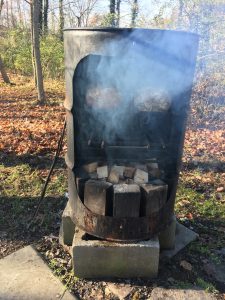
At start-up, the cast iron water pan is topped off, two charcoal chimneys full of briquettes are partially lit (one after the other); then hardwood chunks are placed atop the charcoal.
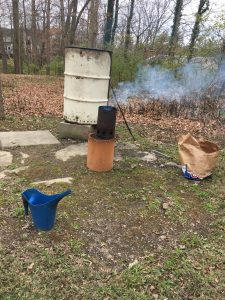
In this mid smoke phase pic, the water pan had just been refilled down the copper fill tube and 2/3 of a starter chimney of briquettes is being partially lit to drop down the 3 inch diameter fuel/flue black-iron pipe. Refilling and refueling requirements average about once every 2 hours. Note that paper from the charcoal bag is used to ignite the briquettes. Other points of interest are the coal flicker (made from a barrel rim) leaning against the smoke-cooker and a small plastic funnel (not visible here) used to refill the water pan.
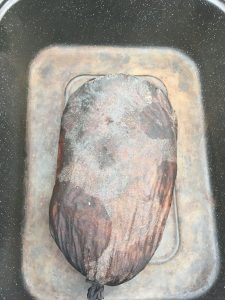
After 5 hours the Italian seasoned butt was pulled from the smoke-cooker and taken to the kitchen sink to rinse soot/fly-ash off the outside of the casing.
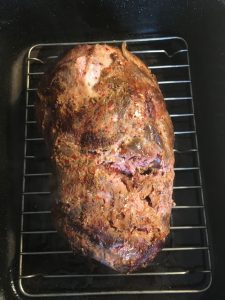
The small amount of liquid in the semipermeable casing was discarded as the casing was striped away. The Italian seasoned roast was then place on a rack in a large rectangular roaster; without any liquid added under the cooking rack. Covered roaster immediately went into a 250F oven. This roast was around 155F internal coming out of the smoke-cooker and hit 200F internal after about 1 3/4 hours of steam-oven cooking.
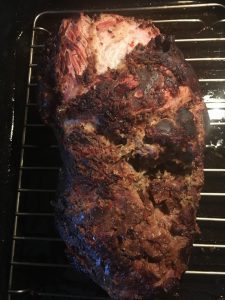
Here’s the Italian butt at 200F internal. The large white spot to the top of the pic is where a piece fell off during transfer to the oven roaster. It was promptly got eaten. The bottom of the roasting pan contained about a cup of accumulated cooking purge; that was comprised of B-vitamins, water soluble meat protein, minerals, rendered fat and some solubilized seasonings. Those drippings were poured off and saved to mix in later with the pulled pork.
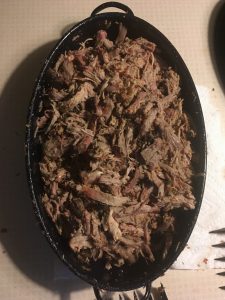
Yield of the Italian seasoned pork shoulder butt. Final removal of trim fat and any other undesirable material was quickly accomplished during hand pulling. Thin fat cap meat was pulled/shredded as well. In the beginning, “bear claws” were used to separate meat because it was too hot to shred barehanded.
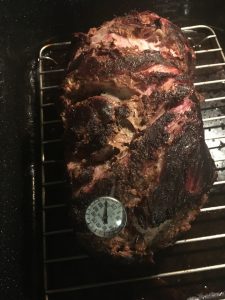
The Polish seasoned butt went from the smoke-cooker and into the oven as soon as the Italian roast came out. The Polish roast was close to 170F internal coming out of the smoker and hit 200F internal after 1 hour of oven steam-cooking.
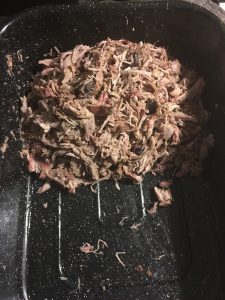
The Polish seasoned butt was immediately shredded and oven cooking purge was mixed back in.
Both types of seasoning butts were served for Black Friday dinner. We also had steak fries that were cooked on top of the stove in a 14 inch diameter cast iron skillet.
The next day (Saturday) I cooked up the rest of the fixings to make Chipotle style meals. Everyone just microwaved a plate whenever they got hungry.
We sent our Holiday weekend guest home with pulled pork and both butts were completely gone by Wednesday. When I got down to the bottom of the bowl the meat was sitting in a thin layer of rendered pork fat. That meat was placed on a plate, that had a paper towel on it, then microwave heated. Most of the hot fat soaked into the paper towel and I then ate the last of the butts. Oh, and our house is a barbecue sauce free zone.
Very inexpensive, very easy and very good.
